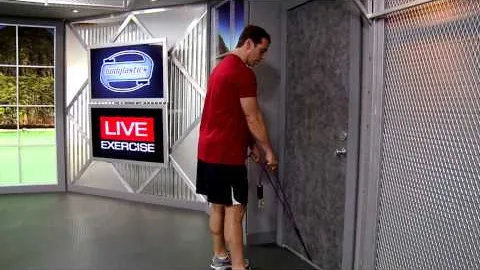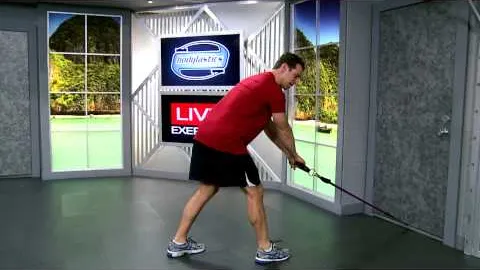

The standing back extension with resistance bands is an effective exercise for improving strength and flexibility in the back muscles. By incorporating resistance bands into this exercise, you can engage your muscles in a targeted and controlled manner. In this article, we will guide you through the proper technique for performing the standing back extension with resistance bands, discuss its benefits, and provide tips for maximizing your results.
Setup: Start by attaching the resistance band to a secure anchor point at waist height. Stand facing away from the anchor point with your feet shoulder-width apart. Hold one end of the resistance band in each hand, crossing it in front of your body.
Engage your Core: Before starting the movement, engage your core muscles by pulling your belly button towards your spine. This will help stabilize your spine and protect your lower back.
Begin the Movement: Slowly extend your arms forward, while simultaneously bending at your hips. Keep your back straight and your knees slightly bent throughout the movement. As you lower your upper body, you should feel a stretch in your lower back.
Return to the Starting Position: Once you have reached a comfortable stretch, slowly return to the starting position by contracting your back muscles and raising your upper body. Be sure to maintain control and avoid any jerky or sudden movements.
Repeat: Complete the desired number of repetitions and sets, gradually increasing the intensity as you become more comfortable with the exercise.
The standing back extension with resistance bands offers several benefits for individuals of all fitness levels:
Improved Back Strength: This exercise targets the muscles in the lower back, helping to build strength and stability. Strengthening the back muscles can reduce the risk of pain and injury during everyday activities.
Enhanced Posture: By strengthening the back muscles, you can improve your overall posture. Good posture not only enhances your appearance but also allows for optimal alignment of the spine, reducing the risk of developing postural imbalances.
Increased Flexibility: The standing back extension with resistance bands also helps to improve flexibility in the lower back. Regularly performing this exercise can enhance your range of motion, making daily movements easier and more comfortable.
Core Activation: In addition to targeting the back muscles, this exercise also engages the core muscles. The core acts as a stabilizer during the movement, promoting a strong and functional core.
Versatility: The standing back extension with resistance bands can easily be modified to suit various fitness levels. By adjusting the resistance band tension or changing the anchor point, you can make the exercise more or less challenging to meet your individual needs.
To get the most out of your standing back extension with resistance bands exercise, consider the following tips:
Warm-Up: Prior to performing any exercise, it is essential to warm up your muscles and prepare your body for physical activity. Incorporate dynamic stretches and light cardio exercises to increase blood flow and flexibility.
Start with Light Resistance: If you are new to resistance band exercises, begin with a lighter resistance band to allow your muscles to adapt and avoid strain or injury.
Focus on Form: Proper technique is crucial for targeting the intended muscles and minimizing the risk of injury. Maintain a neutral spine, avoid rounding your back, and engage your core throughout the movement.
Gradually Increase Intensity: As your strength and flexibility improve, gradually increase the resistance band tension or try different variations of the exercise to continue challenging your muscles.
Listen to Your Body: Pay attention to any discomfort or pain during the exercise. If you experience any sharp or unusual pain, stop the exercise and consult a healthcare professional.
In conclusion, the standing back extension with resistance bands is an excellent exercise for strengthening the back muscles, improving posture, increasing flexibility, activating the core, and accommodating various fitness levels. Incorporate this exercise into your regular routine, following the proper technique and tips provided to maximize your results. Remember to always listen to your body and consult a healthcare professional if needed.
If you're looking for a gym, fitness club or yoga studio, you've come to the right place.
You can find information about gyms in your area. Browse catalog of gyms and find gyms with classes which are you looking for.
On gym page you can find simple information like address, phone or website. You can find list of available classes. You can check availability of personal training or small group classes. On place page you can also see information about open hours.
You can find gyms near you with amenities, courts, studios and equipments.
Use our map to find gym at your city or district.
In Gym Navigator you can find list of exercises with movies for many body parts.
You can browse exercises catalog and find exercises the best of you.
You can also find exercises grouped into workout plans, which you can use to improve you body. Each routine show you exercises one by one and give you possibility to count you progress and count down rest time.